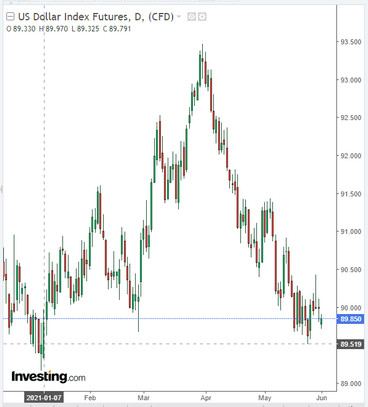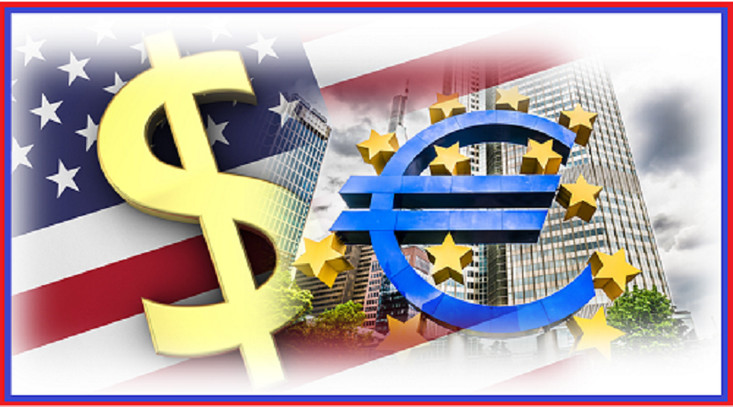As shown by the data published by Eurostat at the beginning of today's European session, consumer inflation in the Eurozone rose by +2.0% in annual terms in May (against the previous figure of +1.6% and the forecast of +1.9%). The core consumer price index (Core CPI) rose in May by +0.9% on an annualized basis (against the forecast of 0.9% and the previous value of +0.7%). Thus, this indicator turned out to be with the highest value since November 2018, confirming the strengthening of inflationary pressures in the Eurozone. And given that the ECB's inflation target is slightly below 2.0%, the euro reacted by strengthening, especially against the pound, to this publication.
Against the dollar, the euro also rose, but less significantly, and the positive impulse received from the publication of the European CPI indices is gradually fading away.
At the time of publication of this article, EUR / USD is traded near the 1.2230 mark, having declined from today's local maximum of 1.2241.
Nevertheless, the pair maintains positive dynamics, strengthening today for the third week in a row. Over the past 2 months, EUR / USD has gained +4.2%, breaking into the bull market zone above the key and long-term level 1.2070, which separates the bull market from the bear market (see Technical Analysis and Trading Recommendations).
Meanwhile, further growth in EUR / USD may be difficult due to the intensifying talk in the market about the growing likelihood of a soon start to curtail the Fed's stimulus policy.
So, at the end of last month, a member of the Fed's Board of Governors and Deputy Head for Banking Supervision Randal Quarles said that the leadership of the US central bank may consider the possibility of discussing the issue of reducing the purchase of assets at one of the next meetings. "If in the coming months my expectations for economic growth, employment and inflation are met, and especially if these indicators turn out to be stronger than I expected, then, as stated in the minutes of the last Fed meeting, it will be important for the FOMC to start discussing the change. the pace of asset purchases at future meetings", Quarles said.
Although short-term interest rates will remain near zero, positive expectations for economic growth make it possible to start curtailing the program of purchases of government bonds and mortgage bonds, Quarles said. If the Fed really begins to curtail the quantitative easing program, then this could lead to an increase in the yield of US government bonds, as well as to the strengthening of the dollar.
Earlier, the President of the Federal Reserve Bank of San Francisco Mary Daly also said that the reduction in asset purchases has already been discussed in the leadership of the Fed, and soon this issue will be raised again.
Thus, more and more representatives of the Fed are talking about the possibility of reducing stimulus, although they are still in the minority.
A decrease in the money supply due to a possible decrease in bond purchases (by $ 120 billion per month at the moment) earlier than expected will also mean a stronger dollar.
Such statements from some of the FRS leaders are alarming investors, who are betting on the further weakening of the dollar. Therefore, the next meeting (in mid-June) of the Fed will be carefully scrutinized for any changes in the rhetoric of statements by its leaders. Although, to say that the decision to start curtailing the incentive program will be made at this meeting is still premature.
The US economy still lacks more than 8 million jobs, and the recent surge in inflation is viewed by Fed officials as temporary.
In this regard, today it is worth paying attention to the speeches (at 18:00 GMT) of the FRS representatives Brainard and Quarles. If the rhetoric of their statements is “pigeon” in nature, then market participants will consider them as the Fed's inclination to continue the stimulating policy in the same volumes, and the dollar will decline.
Otherwise, if Brainard and Quarles question the need to maintain the Fed's stimulus policy at the same levels, the dollar will receive new stimulus to strengthen after it rose late last week amid stronger-than-expected indicators of basic spending on personal consumption of Americans. According to data released last Friday, the price index for personal consumption expenditure (PCE) in the United States in April rose by 0.6% compared to the previous month and 3.1% compared to the same period last year. PCE and Core PCE are inflation indicators preferred by the Fed when determining the prospects for its monetary policy, and a jump to 3.1% could push the Fed to reduce the volume of its bond purchase program.
Also, investors will pay attention today to the publication at 14:00 (GMT) of the index (PMI) of business activity (from ISM) in the manufacturing sector of the US economy, which is an important indicator of the state of the American economy as a whole. Forecast: 60.7 in May (against 60.7 in April, 64.7 in March, 60.8 in February, 58.7 in January, 60.7 in December). The index is above the 50 level and has a relatively high value, which is likely to support the dollar. If the indicator drops below the forecast and, especially, below the value of 50, the dollar may sharply weaken in the short term.
So far, judging by the declining chart of the DXY dollar index, the trend of further weakening of the dollar continues.






